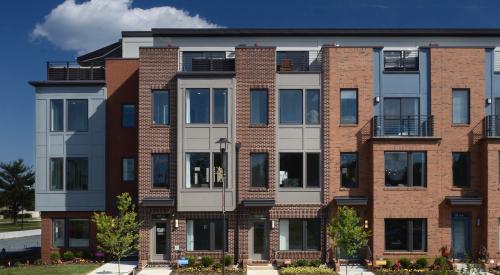|
 |
America's long housing boom (1993 to 2005) fueled a binge at city hall. Municipalities, especially in fast-growing Sun Belt states, got hooked on the funding — for schools, roads, parks, police and even public art — they pulled out of the pockets of home builders desperate to get a building permit.
Impact fees are an intoxicating form of public finance that does not require raising the property taxes of local voters. Elected officials love them because they tap not-yet-enfranchised new residents (including young, first-time home buyers) as well as builders, who can be kept quiet by the fear they will be denied permission to build on land they've already bought with borrowed money.
Better yet, the fees are usually collected when building permits are issued, well in advance of the new home's real "impact" on schools, roads and water treatment plants. Fee revenues sometimes rest, drawing interest, for years before they are used for the intended purpose (if, indeed, they are ever used for it). Local politicos often claim impact fees are a way to make growth pay its own way, as it occurs. In truth, home builders and new home buyers are paying for facilities and services in advance.
No more Mr. Nice GuyFor more than a decade, home builders have taken this abuse passively, passing on the costs to buyers because they feared municipal retribution if they rocked the boat, and because people just kept buying houses — even as home prices were driven higher by the fast-rising fees.
Among themselves, builders sometimes grouse that such fees are a regressive tax that saddles young buyers with a disproportionate share of the cost of infrastructure and public services because they pay twice, first in the price of a new home inflated by impact fees, then again when they pay property taxes along with all the other home owners in the community.
Many builders secretly are seething that impact fees are nothing less than extortion at the hands of public officials. And when we examine the cumulative level to which impact fees have climbed in many municipalities, it's hard to deny a dramatic effect on new housing affordability.
A national survey of impact fee levels across the country, conducted last year and released in August by Austin, Texas-based Duncan Associates, shows an average of $10,496 per single-family home in jurisdictions that use impact fees (which are most common in the South and West, especially California, Florida, Arizona, Colorado, Washington and Oregon). But we found impact fees of more than $30,000 per home in a number of municipalities in California, Florida, Maryland and Illinois.
 |
|
Perry Bigelow |
"Thankfully for us, Aurora has resisted fees based on that concept. But towns north and south of Aurora have them."
If the housing boom had continued, the gravy train would still be running at the same pace into the coffers of municipal governments now addicted to this larceny. But the boom ended in 2005. And while the current housing slowdown is causing agony for home builders, it does have one silver lining: the opportunity to reshape the political landscape and cut impact fees in all the states and housing markets where they are now most prevalent.
Why the time is rightBuilders often say land owners are the last to recognize and accept new price levels when a market cycles down, but local government elected officials are probably even more oblivious to today's new market dynamics. Two years into the slump, many politicians are just beginning to see falling municipal revenues as a problem.
Almost invariably, the first thing that comes to their minds is to raise impact fees. "We had a story in the paper here in San Diego a week ago about the county of San Diego's considering raising impact fees and also plan check and inspection fees," says Mick Pattinson, CEO of Carlsbad, Calif.-based Barratt American Homes and chairman of a new impact fees task force recently launched by California Building Industry Association.
"They concluded that builders are not pulling enough permits, so they need to raise fees. When the market was booming, they couldn't raise fees fast enough. They said they wanted their share," Pattinson laughs, "but now that house prices are falling, they're not even thinking about dropping fees."
We hear similar reactions all across the country. "Take a look at what Collier County (Fla.) commissioners proposed when they saw their revenues crash along with the housing market," says David Hart, Florida Home Builders Association vice president of legislative and governmental affairs. "Their solution was to double impact fees. They just don't get it. They don't realize that if they double the fees, they'll get less revenue, not more."
Because the market is bad, builders are now in a position of strength to negotiate impact fees with municipalities. They can threaten to stop building, liquidate land positions and pull out of a market — and it is no idle bluff.
 |
|
Paul Colgan |
It's time to go eyeball to eyeball with the local jurisdictions and see who blinks first. Our bet is on the builders because municipalities need revenue and they won't get a dime out of an impact fee if no house is built, and builders are not going to build houses at a loss. The local governments will have to negotiate new, lower fees that allow builders to make money, or they will get no revenue at all.
Wins will come at state levelRegional advocacy organizations like Attainable Housing Alliance in Illinois can be effective, especially where they have the mandate to take cases to court and sue municipalities that play fast and loose with nexus requirements in both case law and state enabling legislation. "We're looking for ways to attack the common practice in Illinois of using impact fee revenues for things that are not 'specifically and uniquely attributable' to the development in question," Colgan says. "Road and school impact fees, by law, must meet that test. But we see lots of cases where road impact fees are used on the other side of the county, completely away from the development in question."
Still, the most effective place to fight impact fees seems to be at the state level, especially in the legislature. Start by reshaping the law that frames all impact fees. "Getting a good impact fee enabling law through the state legislature is the best way to attack this problem," says Thais Austin, an infrastructure and public finance specialist for NAHB. "Texas was the first state to pass enabling legislation for impact fees, and it's actually worked to help minimize the use of impact fees in Texas.
"The law limits impact fees to infrastructure uses, and it also limits the geographic area to which fee revenues can be applied," Austin says. "If there's an impact fee, it has to be used to pay for something that specific homeowner actually uses. A park fee has to be used for a park in the neighborhood. A road fee has to be used for a road the homeowner actually drives on. If the infrastructure is used by the whole town, the whole town has to pay for it."
Having good state statutes is important to keep the nexus of fees tight, Austin says, even though some builders regard enabling laws as evil because they legitimize impact fees. "Texas was the first state to pass a law," Austin says. "Others have copied it. It's interesting that Texas is not one of the states where we hear a lot of impact fee horror stories."
Those tales of woe come mostly from California and Florida, in addition to Illinois. "The average impact fee total for a single-family detached home in Florida, excluding water and sewer tap fees, is around $15,000," says Orlando-based housing economist Hank Fishkind, Ph.D. (The Duncan Impact Fee Survey shows Florida single-family home impact fees increased 149 percent between 2003 and 2007.)
 |
|
Hank Fishkind |
"The home builders ought to back legislation at the state level as a way to establish control of the process. I think you'll see some strong moves in many states to put caps and controls on the way impact fees are used. The tenor of the Florida Legislature right now is to control local government revenues very tightly." Fishkind says.
FHBA's David Hart sees benefit in pursuing a policy similar to the one outlined by Fishkind. "Right now, local governments feel they have quite a bit of latitude to interpret the rational nexus test," Hart says. "We've pushed for legislative action to give local governments more direction in how those funds must be spent. We'd also like to see some kind of audit, so we know how much has been collected each year. I don't know if we need a new law, or just tightening of the existing one."
Hart says Florida's current push to lower local property taxes complicates the discussion of impact fees and partially explains their upward movement. "We've been telling our legislators for two years that when they push down local governments' ability to tax property, they'll find that revenue somewhere else. Until they cap all local government revenues, they'll use impact fees to fill the gap."
Hart notes that Florida fees now range from $0 in some less populated counties to $41,000 in the Naples market in Collier County.
Get fired upIn Southern California, Pattinson reports impact fees now average $50,000 for a single-family detached home, and push into the $100,000 range in some municipalities. It's intolerable, he says, which led CBIA to form the Impact Fee Task Force. "You can't pay $50,000 a house to support city infrastructure or government services and expect to deliver a product that customers will buy," he says. "In '04 and '05, California issued over 200,000 building permits. Last year, it was 115,000. And this year, it will fall even more. The entry level and first-move-up segments are just gone. How can anyone believe that a $100,000 impact fee can be absorbed without affecting affordability?"
Pattinson's task force is trying to get fees applied at certificate of occupancy rather than at building permit stage. "That would save a lot of money," he says, "and after all, there is no impact until the house is occupied. We're beginning to see some cities accept that. I think we'll have success with that innovation across the state.
"Getting fees reduced will be harder. That will take legal action," Pattinson says. "What we really need to do is stir up the builder members of CBIA. We've been passive for too long."
That's good advice, and a rallying cry, for every builder facing impact fees. PB
|
















